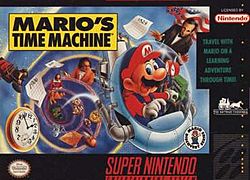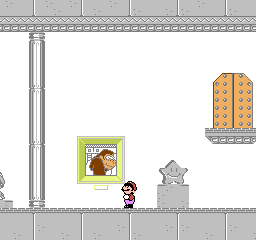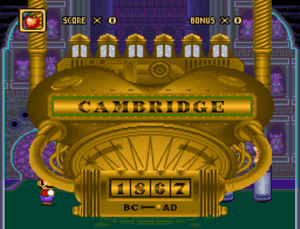Mario's Time Machine facts for kids
Quick facts for kids Mario's Time Machine |
|
|---|---|

Super NES packaging
|
|
| Developer(s) | The Software Toolworks Radical Entertainment (NES) |
| Publisher(s) | The Software Toolworks |
| Designer(s) | Don Lloyd |
| Programmer(s) | Joe Senior (SNES) Kevin Shapiro (SNES) Brian Carpenter (NES) |
| Artist(s) | Cesar De Castro (PC/SNES) Rob Oliveria (NES) |
| Composer(s) | Mark Knight John Korsrud (NES) |
| Series | Mario |
| Platform(s) | MS-DOS, Super NES, NES |
| Release date(s) | MS-DOS
|
| Genre(s) | Educational |
| Mode(s) | Single player |
Mario's Time Machine is an exciting educational video game. It first came out for MS-DOS computers. Later, it was released for the NES and Super NES consoles. The Software Toolworks made and published the MS-DOS and Super NES versions in 1993. Radical Entertainment developed the NES version, which The Software Toolworks published in 1994. An updated MS-DOS version, Mario's Time Machine Deluxe, came out in 1996.
This game is one of several educational Mario games from the early 1990s. It focuses on teaching players about human history. While the way you play changes a bit between the different versions, the main story is similar. You play as Mario, who uses a time machine. His goal is to return important artifacts that Bowser has stolen. These artifacts must go back to their correct times in history.
Mario's Time Machine got mixed to negative reviews when it was released. People had different opinions on how well it taught history. Some compared it to another history game, Where in Time Is Carmen Sandiego?
Contents
How to Play: Saving History with Mario
The game starts in the year 1993. Bowser has built a time machine called the "Timulator." He uses it to travel back in time and steal important artifacts. Bowser wants to display these items in a museum inside his castle. If he succeeds, these actions will change history forever. So, Mario takes control of the Timulator to put the artifacts back where they belong. In the NES version, Bowser also kidnaps Yoshi. Yoshi is set free once you finish the game.
The main goal of the game is to teach you about the history of each artifact. You also learn about the famous person connected to it. To move forward in the game, you must answer questions correctly. These questions are about the historical facts you learn.
Game Controls and Movement
Mario's Time Machine uses a side-scrolling view. The way you control Mario changes depending on the version. In the MS-DOS version, you use a point-and-click style. This means you click on things to interact. The console versions (NES and Super NES) use a platforming style. This is similar to Super Mario World. Mario can move left, right, and jump. Like Mario Is Missing!, the console games use a password system. This lets you save your progress and continue playing later.
Bowser's Museum and Time Travel
You start Mario's Time Machine in Bowser's museum. This museum is like a main hub. Here, you get the stolen artifacts. From the museum, you can directly go to all the game's levels. These levels are different places on Earth in various time periods. You use the Timulator to travel.
In the Super NES and MS-DOS versions, for each artifact, you learn its original year and place. For example, you might learn that an "Apple" artifact came from 1687 Cambridge. You then use this information to time travel. Time traveling itself is a minigame. Mario surfs through a big ocean, collecting mushrooms. If you collect enough mushrooms, Mario travels to the time and place you chose.
Learning History and Returning Artifacts
Once you arrive, you get a short document. This document describes the life of the historical person linked to the artifact, like Isaac Newton. However, some words are missing from the document. You need to talk to the non-player characters (NPCs) in that time period. These NPCs are like the local people. They give you facts that help you fill in the blanks. You choose words from a list. If you pick the wrong word more than twice, you are sent back to 1993. You then have to try again. When you fill all the blanks correctly, you can return the artifact to its owner.
Ending the Adventure
In the game's final cutscene, Mario faces Bowser. Bowser then steals the Timulator back to escape. There are three possible endings. These depend on how well you played. In the worst ending, you don't return the artifacts fast enough. Bowser escapes to a place called Paradise. In the other two endings, the Timulator breaks down. This sends Bowser and traps him in the Jurassic era.
NES Version Differences
The NES version of Mario's Time Machine focuses more on platforming. Even though there are enemies, Mario cannot lose lives or take damage. This means you can't get a game over. To get an artifact in Bowser's museum, you play a Mario Bros.-inspired minigame. In this game, you fight Koopa Troopas.
After getting an artifact, you can use the Timulator. You can travel to one of fourteen time periods. Unlike the other versions, the game doesn't tell you exactly where the artifact came from. You need to explore the time periods. You get hints from local people or from special message blocks. Once you figure out which artifact belongs in that time period, you place it back. After all artifacts are returned, you answer three random multiple choice questions. These questions are about the historical periods you visited. Answering them correctly leads you to the final boss fight with Bowser. You win the game when you defeat Bowser.
See also
 In Spanish: Mario's Time Machine para niños
In Spanish: Mario's Time Machine para niños



